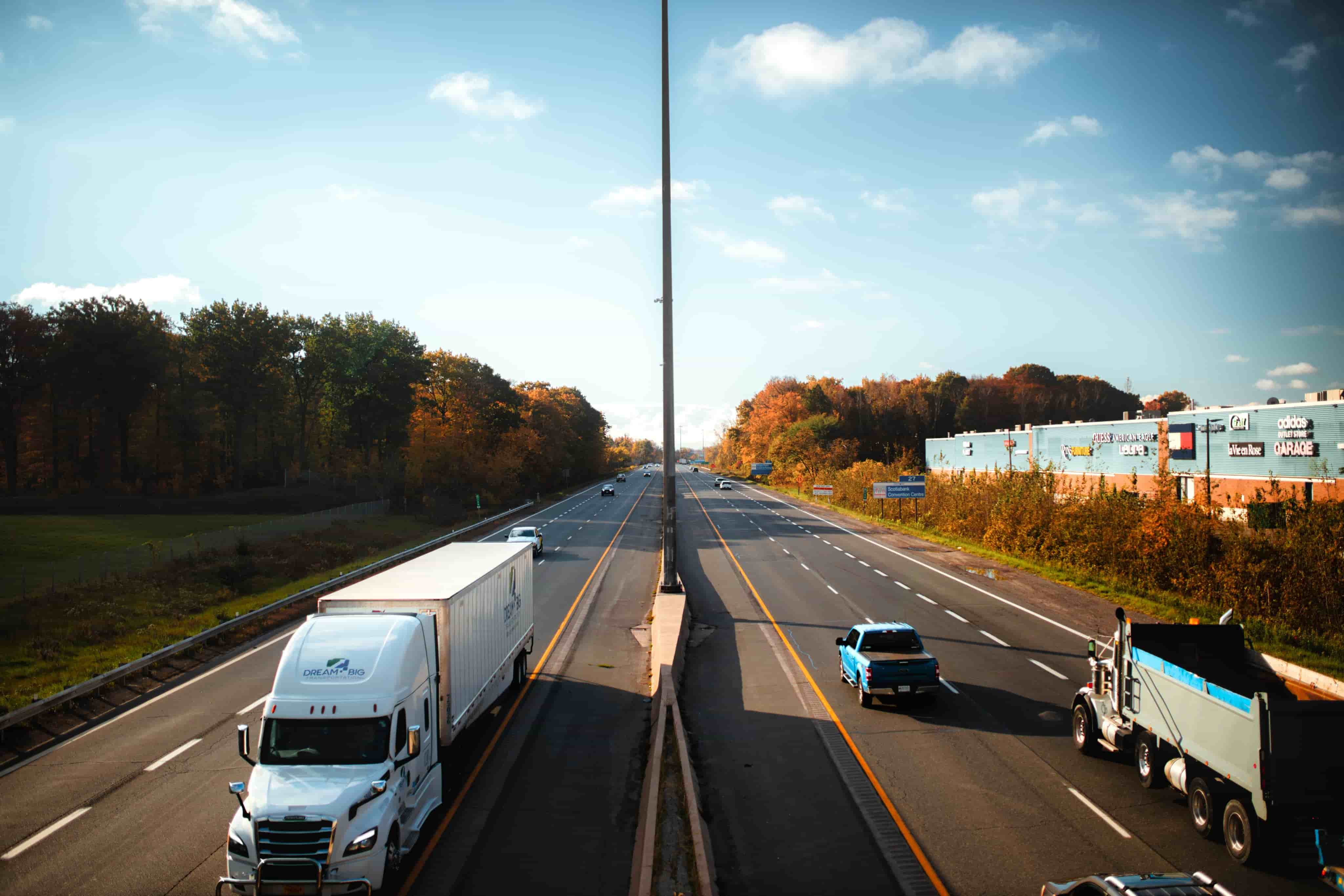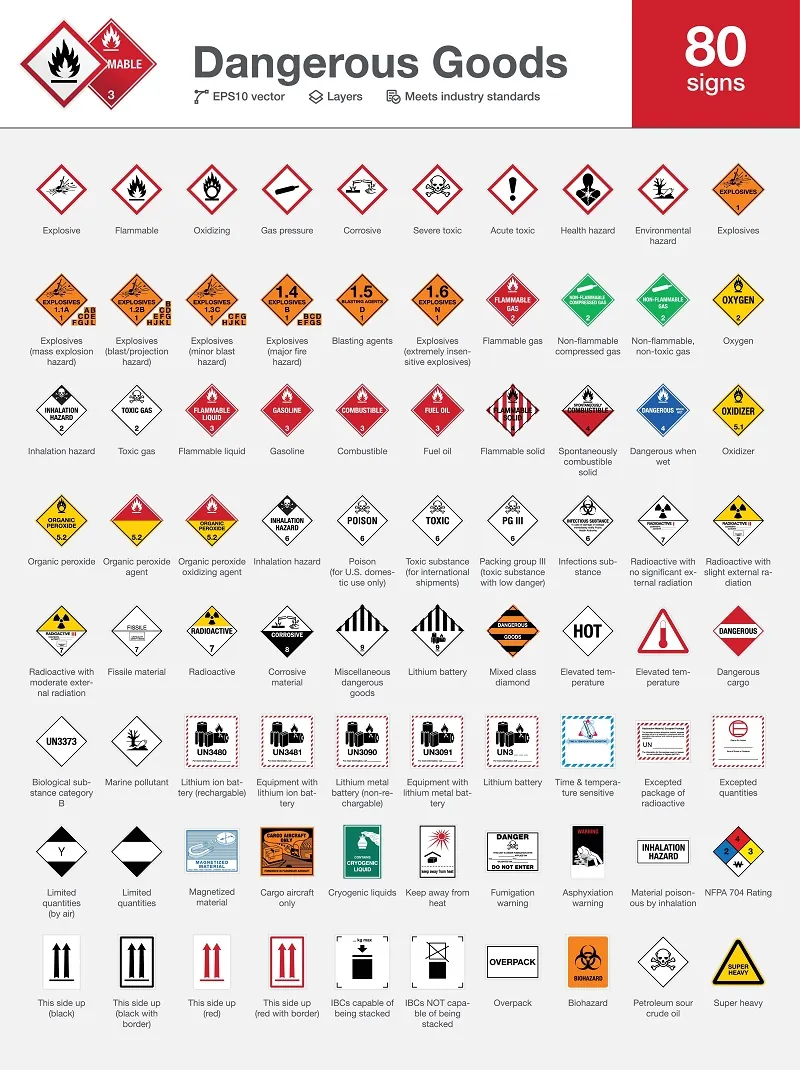
Hazardous Materials Shipping Guide
With FreightCenter's expert guidance, ensure safe and compliant transportation of hazardous materials. Learn about hazmat classifications, regulations, and shipping best practices. Get a freight shipping quote, or call our experts.
What Are Hazardous Materials (Hazmat)?
Shipping hazardous materials, or hazmat, involves transporting substances that pose risks to health, the environment, property, or safety. These items, which can be flammable or toxic, require careful handling to prevent accidents and ensure compliance with regulations.
The U.S. Department of Transportation (DOT) classifies hazardous materials into specific categories to ensure safe and compliant transportation. This comprehensive guide will help you understand the DOT hazard classes for your shipment, making it easier to find the best contract freight carriers that adhere to DOT safety and transportation regulations. Use this resource to navigate the complexities of hazmat shipping and ensure the secure handling of your materials.
DOT Hazmat Regulations and Hazard Classes:
Shipping hazardous materials is heavily regulated by international and national agencies. For instance, the International Air Transport Association (IATA), International Maritime Dangerous Goods (IMDG) Code, and the U.S. Department of Transportation (DOT) provide specific guidelines for the packaging, labeling, documentation, and transportation of hazardous materials. These regulations ensure the safety of individuals, the environment, and the transportation process itself.
Hazard Classifications:
Hazardous materials are classified based on their properties, potential risks, and handling requirements. For a full guide, visit The Department of Transportation.
| DOT Hazardous Classes | Category | Example |
|---|---|---|
| Class 1 | Explosives | Ammunition |
| Class 2 | Gases | Propane Tanks |
| Class 3 | Flammable Liquids | Gasoline |
| Class 4 | Flammable Solids | Matches |
| Class 5 | Oxidizers | Hydrogen Peroxides |
| Class 6 | Poisons & Etiologic Materials | Pesticides |
| Class 7 | Radioactive Material | Medical Isotops |
| Class 8 | Corrosives | Sulfuric Acid |
| Class 9 | Misc. Dangerous Substances & Articles | Lithium Batteries |
Explosives (Class 1): This class includes materials capable of causing an explosion, such as fireworks and ammunition. Class 1 explosives have an orange placard with their hazard class, division number, or compatibility letter at the bottom.
Gases (Class 2): Gases are categorized as flammable, non-flammable, toxic, or oxidizing. Gases are often compressed, liquefied, or dissolved under pressure. Packaging for gases includes specialized cylinders or containers that can withstand pressure changes. Commonly transported class 2 dangerous goods are oxygen, lighters, and aerosols.
Flammable Liquids (Class 3): Flammable liquids have a low flash point and can easily catch fire. Examples include gasoline and alcohol. Packaging for flammable liquids must prevent leaks and be resistant to ignition sources. Proper labeling consists of a white or black flame with the number 3 at the bottom on a red diamond-shaped placard.
Flammable Solids (Class 4): Flammable solids can ignite easily due to friction, heat, or exposure to moisture. These include substances like matches and magnesium. Packaging for flammable solids needs to prevent friction and moisture contact. Proper labeling consists of a black flame with the number 4 at the bottom on a red diamond-shaped placard.
Oxidizers and Organic Peroxides (Class 5): These materials can enhance combustion and make fires burn more intensely. They need proper packaging to prevent contact with combustible materials and to avoid reactions that could lead to fires or explosions. Proper labeling consists of a black flame over a circle with the number 5.1 at the bottom on a yellow diamond-shaped placard. Organic Peroxides are class 5.2 and would be a black or white flame with the top half of the diamond placard red and the bottom half yellow.
Toxic and Infectious Substances (Class 6): This class includes materials that can cause harm to humans or the environment. Packaging for these materials should prevent leaks, spills, and contact with people or other substances. These labels have a skull with crossbones at the top and the number 6 at the bottom of the diamond placard. Division 6.2 is for infectious substances, and the biohazard symbol is used with the number 6.2 at the bottom.
Radioactive Materials (Class 7): Radioactive materials emit ionizing radiation and require specialized packaging to prevent exposure to individuals and the environment. Commonly transported class 7 goods are radioactive ores and isotopes. This label has a black trefoil icon at the top, with the placard having a white background. Mandatory text in the lower half of the label: Radioactive, Contents, and Activity. A category one radioactive needs a red bar next to the word radioactive. A Category 2 radioactive should have the top half of the placard being a yellow background and two red bars next to the word Radioactive. Category 3 is the same as category 2, except it has 3 three red bars next to the word Radioactive. All three placards should have the number 7 at the bottom of the diamond placard.
Corrosive Materials (Class 8): Corrosive substances such as acids and batteries can damage other materials upon contact. Packaging for corrosive materials should prevent leaks and corrosion of the packaging itself. The label should have a symbol of liquids spilling from two glass vessels and attacking a hand and a metal. The top half of the diamond placard is white, and the bottom half is black with a white number 8.
Miscellaneous Dangerous Goods (Class 9): This class includes materials that don’t fit neatly into the other categories but still pose risks during transportation. Some examples are marine pollutants and lithium-ion batteries. The label has seven vertical stripes in the upper half of the diamond placard. The background is white, and the number 9 is underlined in the bottom corner.

Hazardous Materials Shipping Guide: Classifications, Regulations, and Best Practices
How Do You Ship Hazardous Materials?
Our Quick Quote form online includes a box to select the “Hazmat” service option. The extra cost to ship hazmat will be in the price. Keep in mind that not all carriers can handle Hazmat freight.
Licensed carriers in the U.S. are required to indicate hazmat by a diamond-shaped sign. The color of the diamond will show the type of hazard the product represents.
General Packaging Guidelines:
Refer to the U.S. DOT for specific regulations. This is meant to give you a general overview of the requirements.
Packaging for hazardous materials typically includes:
- Primary packaging (containers holding the hazardous material)
- Secondary packaging (protective packaging to prevent leaks or spills)
- Outer packaging (provides additional protection and houses the primary and secondary packaging)
- Extra cushioning and absorbent materials as needed
Labeling requirements include:
- Proper shipping name: The accurate name of the hazardous material.
- UN number: A unique four-digit number assigned to each dangerous material.
- Hazard class: The class of dangerous material.
- Packing group: A classification that indicates the level of danger within a hazard class.
- Symbols and pictograms: Visual representations of hazards, such as flame or toxic symbols.
- Emergency contact information: Information to reach responsible parties in case of emergencies.
Impact on Transportation:
Proper packaging, labeling, and classification are critical to ensuring the safety of individuals, the environment, and transportation personnel. Failure to comply with these regulations can result in accidents, leaks, spills, fires, and even explosions during transportation.
Transportation authorities, carriers, and shippers must follow these regulations:
- Prevent accidents and emergencies during transportation.
- Protect transportation personnel and the general public from exposure to hazardous materials.
- Minimize the risk of environmental contamination.
- Facilitate emergency response in case of accidents.
Modes of Transporation with Hazardous Materials
Different modes of transportation (air, sea, road, rail) have their own sets of regulations and guidelines for transporting hazardous materials.
Air Transportation:
Following the International Air Transport Association’s (IATA) Dangerous Goods Regulations is essential when sending dangerous materials by air. These rules protect everyone on the plane, including passengers, crew, and cargo.
Here are some key points to consider:
- Restrictions: Some hazardous materials are prohibited from air transport due to their potential risks. Others may be allowed under specific conditions or restrictions.
- Packaging and Labeling: Packaging for air transport must meet IATA’s requirements, which may differ from other modes. Proper labeling, markings, and documentation are crucial for air shipments.
- Quantity Limits: IATA sets quantity limits for specific hazardous materials on passenger and cargo aircraft to ensure safety.
- Security Measures: Hazardous materials may require additional security measures, such as screening and inspection, to prevent tampering or unauthorized access.
Ocean Transportation:
Transporting hazardous materials by sea follows the guidelines of the International Maritime Dangerous Goods (IMDG) Code. Details to consider:
- Segregation and Stowage: Different hazardous materials must be properly segregated to prevent reactions or dangerous interactions. Stowage requirements ensure safe placement on vessels.
- Container Types: Hazardous materials may require specific types of containers to prevent leaks, spills, or reactions with the container material.
- Emergency Procedures: Ships must have proper emergency plans and equipment to handle hazardous material incidents at sea.
- Container Inspection: Shipping containers carrying hazardous materials must undergo thorough inspections and checks to ensure compliance.
Road Transportation:
Road transport of hazardous materials within a country is subject to national regulations, such as those outlined by the U.S. Department of Transportation (DOT). Key considerations include:
- Placarding: Vehicles transporting specific quantities or types of hazardous materials must display placards indicating the hazard’s nature.
- Driver Training: Drivers of vehicles carrying hazardous materials must undergo specialized training to ensure they are aware of proper handling, emergency response, and regulatory requirements.
- Route Planning: Some hazardous materials are restricted from specific routes or areas, and drivers must plan routes accordingly.
Rail Transportation:
Transporting hazardous materials by rail also involves adherence to national regulations, often aligned with DOT guidelines. Key points include:
- Train Consists: Trains transporting hazardous materials must follow specific configurations and arrangements to ensure safety.
- Communication: Rail carriers must have efficient communication systems to relay information about the hazardous materials being transported.
- Emergency Response: Rail cars carrying hazardous materials must have proper emergency response equipment, and rail personnel should be trained to handle hazardous material incidents.
Emergency Contacts:
Shippers of hazardous materials should provide accurate and up-to-date emergency contact information on shipping documents. The appropriate parties can be reached in an emergency for guidance and support. A common emergency response company is Chemtrec. Their services do require registration.

Different Levels of Hazardous Material
Here’s how the National Fire Protection Association rates hazmat in the United States:
- Red | Flammable
- Blue | Health Hazard
- Yellow | Instability Hazard
- 4 | Lethal or explosive
- 3 | Permanent injury cause
- 2 | Temporary injury or chemical change
- 1 | No hazard or stable
Material safety data sheets (MSDS) are a must when handling or shipping most hazardous materials. This paperwork provides in-depth information about the shipment and how it will be transported.
Overall, it will provide safety guidance and a first aid process for exposure. Review the MSDS procedures before shipping any hazmat product.
Also, make extra copies of the safety data sheets included with the shipment.
While setting up transit, make sure to package materials according to the regulations for goods with correct and marked containers. Let the carrier know in advance the specifics of the materials you are setting up for transport.
To create value for our customers by delivering customized shipping solutions that meet their unique needs and to fulfill shipping demands from simple to complex with expertise, guidance and ingenuity.
Less than Truckload (LTL) is a cost-effective freight transportation mode for shippers with smaller shipments that don't require a full truckload. FreightCenter offers LTL shipping services from a vast network of carriers, providing shippers with competitive rates and reliable transit times.
FreightCenter offers Full Truckload (FTL) services for shippers looking to move large, oversized, or high-value freight. With FTL, shippers can secure an entire trailer for their freight, ensuring faster transit times and reduced risk of damage or loss. Our FTL services are cost-effective and reliable, making them an ideal choice for businesses that require full truckload shipments.
Specialized transportation is a mode of freight transportation that involves unique equipment, expertise, and handling techniques to transport freight that standard transportation modes cannot move. This can include oversize, overweight, or oddly shaped cargo, hazardous materials, high-value goods, or items that require specialized handling. At FreightCenter, we offer specialized transportation solutions to meet the unique needs of our customers.
Expedited shipping is a specialized service that offers faster transit times than standard shipping. FreightCenter provides expedited shipping solutions for time-sensitive freight that needs to be delivered quickly. Our team of experts will work with you to determine the best-expedited shipping option for your specific needs, whether air freight, exclusive use vehicles, or other expedited services.
Ship Hazmat With FreightCenter
Have any questions? Let FreightCenter help! We are experts when it comes to shipping products both nationally and internationally. Our freight agents can ease you into the process to ensure a smooth ride for you and your shipment.
Use FreightCenter’s freight shipping quote tool to begin. Call our shipping experts at 800-716–7608 for other locations. Saving money doesn’t have to cost more in the long haul: Let FreightCenter be your “one-stop shipping solution.”
Hazmat Shipping FAQ
Q. What are hazardous materials, and what precautions should I take when shipping them?
A: Hazardous materials refer to substances that possess the potential to cause harm to humans, the environment, or property.
Q: How can I determine if the material I intend to ship is hazardous?
A: Determining whether a material is hazardous can be complex, as it depends on factors such as chemical composition, physical properties, and intended use. Regulatory agencies, such as the Environmental Protection Agency (EPA) or the Occupational Safety and Health Administration (OSHA), provide comprehensive guidelines and classifications to identify hazardous materials.
Q. How much does it cost to ship hazardous materials?
A. Shipping hazardous materials through a freight carrier can involve additional costs due to the specialized packaging, handling, and transportation requirements associated with these materials. The actual cost will depend on several factors, including the type and quantity of hazardous materials being shipped, the distance of the shipment, the mode of transportation (such as by air, land, or sea), and any additional services or regulations that may apply.
Q. What regulations must be followed for shipping hazardous materials?
A. When shipping hazardous materials, it is important to follow specific regulations. These regulations require a proper description of the goods on shipping papers, including the correct shipping name, hazard class, and identification number. Additionally, a certification must be signed to ensure compliance.
Q: Are there specific labeling requirements for hazardous material shipments?
A: Absolutely. Proper labeling is crucial when shipping hazardous materials. Every package containing hazardous materials must display hazard labels, placards, and markings that indicate the nature of the material and the potential risks associated with it. These labels help inform individuals handling the shipment about the necessary precautions they should take.
Q: What documentation is necessary for shipping hazardous materials?
A: Shipping hazardous materials involves specific documentation to ensure compliance and traceability. Depending on the mode of transportation, these may include a hazardous material shipping declaration, a bill of lading, a shipper’s declaration, and a safety data sheet (SDS). The documentation should accurately describe the material, its classification, and any required emergency response information in case of accidents or spills.

Did You Know?
What are SCBA and APR?
SCBA (Self Contained Breathing Apparatus)
Self-contained breathing apparatus (SCBA) is a helmet for protection against low oxygen, dust, and gasses. To avoid mixing SCBA with scuba, SCBA helmets are for above and underwater use, not for hazmat.
However, scuba gear is mainly for below-sea-level use. These are mostly worn at waste managing plants, aboard ships or plains, and in tunnels. In a fire, you may see a firefighter wear an SCBA helmet.
APR (Air Purifying Respirator)
There are many acronyms for APR, but we are not talking about your credit card. However, an air purifying respirator (APR) is necessary to filter any harmful elements from the lungs. While wearing an APR, you can safely enter an infectious or dangerous site.



